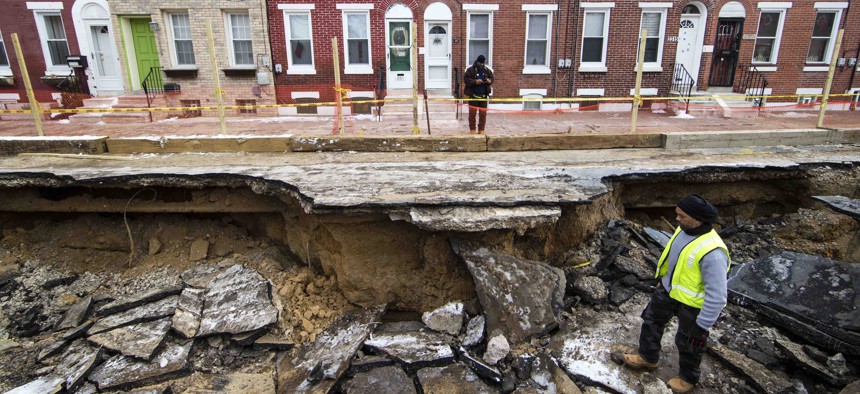An Infrastructure Information Gap States Are Struggling to Solve

Workers inspect a sinkhole in Philadelphia, Monday, Jan. 9, 2017. The Philadelphia Water Department said a water main break caused the sinkhole to open up on the street. (AP Photo/Matt Rourke)

Connecting state and local government leaders
Getting a grasp on deferred maintenance has proven to be difficult.
CHICAGO — State and local governments still have a long way to go when it comes to documenting and reporting maintenance backlogs with infrastructure like roads and schools.
The inconsistent and incomplete information that’s available on deferred maintenance for public assets is an issue that has attracted the attention of researchers, ratings agencies, and others in recent years. But a widespread solution for filling in this information gap has yet to emerge.
“It’s really the time to establish some kind of regular practice,” Jerry Zhao, a professor at the Humphrey School of Public Affairs and the director of the Institute for Urban & Regional Infrastructure Finance at the University of Minnesota, said at an event here earlier this week.
“It’s an issue of transparency,” he added, noting that it is also a matter of raising awareness among members of the public about the extent to which public works are in need of upkeep.
Zhao made his remarks during an event focused on public finance issues that was organized by the Volcker Alliance and other groups and held at the Federal Reserve Bank of Chicago.
One of the other speakers was Mary Murphy, a project director with the Pew Charitable Trusts, who is currently working on research related to deferred maintenance for state-owned buildings, like offices, schools and prisons.
The project has involved asking basic questions about state requirements and processes for reporting on deferred building maintenance. “A lot of what we were hearing in talking to folks in the states was: ‘We’re really struggling to make progress in this area,’” Murphy said.
That’s not necessarily because state officials don’t recognize the importance of collecting this information, she added. It’s often due to the fact that they lack the resources to do so.
One of the questions the Pew researchers have asked is whether states have a comprehensive inventory of their real estate assets. In other words, can they report on all of the buildings they own and maintain. “A minority of states told us that they could do that,” Murphy said.
The researchers have also dug into whether states can provide a “conditions assessment,” about what kind of shape their buildings are in.
An issue with building condition information is that it needs to be updated regularly for it to be useful. Murphy noted that Louisiana said it had done a conditions assessment before Hurricane Katrina in 2005. Since then, some of the cataloged buildings have been taken out of service.
To prioritize maintenance investments, a state would ideally have both a full inventory of its assets and an up-to-date conditions report. And the information would be in a format that is easy to access and understand for policy makers deciding how to spend on projects.
Murphy said some states are making progress. “There are some promising examples,” she said.
Utah, for instance, has a process in place to dedicate maintenance funds for newly approved capital projects. Minnesota is moving ahead with an asset inventory effort. And Wyoming is expanding a system it has for evaluating K-12 school buildings to other state properties.
Matt Fabian, a partner with the research firm Municipal Market Analytics, recounted how when federal lawmakers were deciding how to provide aid for infrastructure in the midst of the Great Recession, he unsuccessfully advocated for an “infrastructure census.”
This, he said, would have involved hiring workers to create a national catalog of assets.
Fabian pointed out that when maintenance slips, and public works decay, there are costs from the disrepair that are borne by residents.
“It’s a tax,” he said.
The costs might include added wear and tear on vehicles due to rough roads, lost time due to transit delays, or public health risks from antiquated water systems.
Ronald Fisher, an economics professor at Michigan State University, highlighted another issue that’s related to infrastructure maintenance and the public dollars available for it.
Research shows that taxpayers often overestimate what they pay in taxes and fees (such as those that go to fund infrastructure), he said. Likewise, he suggested people tend to underestimate how expensive it is to build and maintain public works.
Fisher cited an estimate for road building costs that pegs the price of one mile of interstate in an urban area at $10 million. “If you drive 10 miles on one of those kinds of roads to work every day, you are using a $100 million asset twice a day,” the professor said.
He added: “Even if we can measure infrastructure needs, how are we going to develop the kind of popular support for proposals to solve these problems?”
Bill Lucia is a Senior Reporter with Government Executive's Route Fifty and is based in Washington, D.C.

NEXT STORY: During Hurricanes, Solar Proves to Be Resilient





